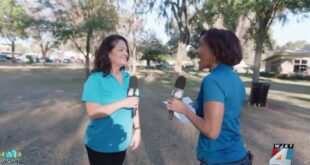Viral video sparks conversation on racial tensions in America
A viral video capturing a chaotic brawl along Montgomery, Alabama’s riverfront has reignited discussions about racial tensions in the United States. The fight initially broke out between a group of White boaters and a Black co-captain of a riverboat, and quickly escalated when bystanders joined in. Arrest warrants have been issued for three men involved in the altercation, but authorities determined that the incident did not meet the criteria for charging hate crimes or inciting a riot.
Despite this, speculation regarding the motivations behind the brawl, which appeared to be divided along racial lines, has continued. The video quickly spread on social media, with some viewers commending the Black bystanders who rushed to the defense of the co-captain, even swimming to his aid. While jokes and memes circulated, historians emphasized that this incident once again thrusts Montgomery into the center of conversations about race.
A deep-rooted racial history
Montgomery’s downtown area, close to where the brawl took place, is marked by a historical memorial acknowledging the city’s involvement in the trans-Atlantic slave trade. Historian and University of Alabama’s Department of History chair, Joshua D. Rothman, highlighted Alabama’s significant role in the domestic slave trade before the Civil War. Thousands of enslaved individuals were transported through steamboats and railroads from New Orleans up the Alabama River to Montgomery, partially constructed by slave labor. These individuals would arrive at Montgomery’s riverfront or train station, where they would be chained together and paraded down Commerce Street before being sold in slave markets within the city. By 1860, there were over 435,000 enslaved individuals in Alabama, solidifying Montgomery as a prominent hub for the slave trade.
Enslaved labor was not limited to the slave trade but also pervaded various aspects of life within Montgomery. Its impact could be seen in the local economy, political structures, and religious institutions. The legacy of slavery influences present-day Montgomery, leaving a lasting impact on society.
The “Cradle of the Confederacy”
Montgomery earned the nickname “Cradle of the Confederacy” because it briefly served as the first capital of the Confederate States of America in 1861. After Abraham Lincoln’s election as president, eleven states seceded from the union. Representatives from six of these states convened in Montgomery to establish their own government. However, the Confederate capital later moved to Richmond, Virginia. This historical designation ties Montgomery to the origins of the Confederacy.
Montgomery and the Civil Rights Movement
Montgomery played a vital role in the Civil Rights Movement, gaining national attention during the Montgomery Bus Boycott. This significant protest against segregation started in December 1955, following Rosa Parks’ arrest for refusing to give up her bus seat to a White individual. The boycott aimed to challenge segregated seating on city buses, with Black Americans refusing to ride them. Eventually, in November 1956, the US Supreme Court ruled such laws unconstitutional. This boycott marked the first major protest against segregation, propelling the Civil Rights Movement forward.
Additionally, Montgomery was a focal point during the Selma March in 1965. Demonstrators marched from Selma to Montgomery to advocate for equal voting rights for Black Americans. However, the march turned violent when state troopers attacked the protesters on the Edmund Pettus Bridge, leaving many injured. The event, known as “Bloody Sunday,” generated national outrage and eventually led to the passage of the Voting Rights Act later that year.
Reflections on slavery
In April 2018, the National Memorial for Peace and Justice was inaugurated in Montgomery. This museum honors victims of lynching and the enslaved, serving as a poignant reminder of the horrors of slavery within the city. Additionally, the Equal Justice Initiative’s Legacy Museum is located on the site of a former warehouse where Black individuals were bought and sold as slaves.
Montgomery’s racial history continues to shape its present-day reality. In 2019, the city achieved a significant milestone by electing its first Black mayor, Steven Reed, 54 years after the memorable Selma March.
This viral video and the ensuing conversations underscore the complex and deeply ingrained racial tensions that persist in America. Montgomery’s rich history provides the context necessary to better comprehend the origins of these tensions and reflect upon the systemic impact of slavery and segregation on the city and the nation as a whole.
 Mind Uncharted Explore. Discover. Learn.
Mind Uncharted Explore. Discover. Learn.




